Blog
Why you should not rank onramps based on fees - Part II
Why Priced-based ranking is not the best choice?
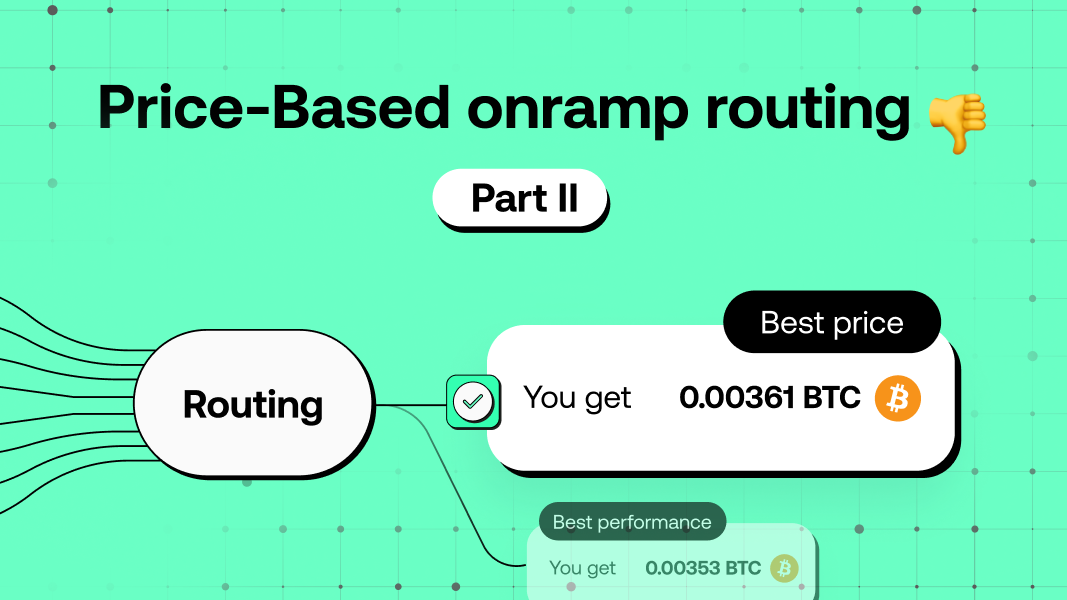
Price-based on-ramp ranking hurts your user experience. In Part I we covered how ramps lure users with low quotes, only to raise fees mid-transaction and drive them away.
But the problem runs deeper.
Not all ramps are created equal
Price-based ramps marketplaces assume that conversion from ramp to ramp is similar. Nothing could be further from the truth.
The sad reality is that ramps transactions fail more often than not.
Credit cards get declined, bugs cause delays and rejections, and KYC friction results in users giving up mid-transaction.
Pushing users to the ramp that is cheapest is like sending drivers down the shortest road without checking for speed limits and traffic jams. Sure, it may seem like a good idea, but the delays and traffic jams are likely to cost both the user and the ramps provider in the end.
It’s all about conversion
It's not just about who offers the lowest quote—it's about who can deliver results. In an industry where trust is everything, failed transactions create frustration, and frustration creates churn.
When a user’s credit card is declined or they abandon the transaction process due to a poorly designed interface, you've lost more than a completed transaction—you’ve likely lost a customer.
A ramp might rank at the top of your ranking because of low fees, but if only 50% of users complete their purchases, the real cost is steep—up to 50% in lost revenues.
What if there’s a ramp that has lower fees, but does not engage in questionable pricing tactics that break user trust? Or what if there’s a ramp with a 75% success rate but doesn’t get used because it is slightly more expensive?
A successful user experience should select the ramp with the highest conversion rate, the least friction in KYC, and the smoothest user flow.
Comparing the ‘average’ vs the best ramp
When comparing ramps, it’s crucial to look beyond just the price.
The best-performing ramps, those that consistently convert transactions, have a much higher success rate. For example, while the lowest-priced ramp may convert at an average of 50%, the top-rated ramp by conversion might achieve Y%. That’s a 50% boost in completed transactions, which directly translates to increased revenue and happier users.

The image above illustrates the stark difference between selecting a ramp based on conversion rates versus selecting one based purely on price. The choice is clear: better performance drives better results, and that’s what keeps users coming back.
The danger of not understanding returning users
It's simple math: the more successful ramp transactions, the more users are onboarded. These same users will come back and use dApps, staking swaps, and so on. The best ramp isn’t the cheapest—it’s the one that keeps users coming back.
Imagine you are a user, who has previously bought crypto through a ramp in your wallet. If suddenly another ramp has become cheaper than the ramp they used previously, you are forcing that user to sign up and go through KYC all over again.
Returning users convert more than 5x better than new users, but only when sent to the right ramp!

Moving beyond price-based ranking means understanding which ramp to recommend to each individual user. For returning users, this means recommending or labeling the ramp they have previously used in order to make checkout as easy as possible!
Why Onramper's ranking system is different
Onramper’s ranking system doesn’t fall into the price trap. It evaluates ramps based on many real-time performance metrics:
- Conversion rates
- Transaction success
- Returning users
- Pricing
- User experience
This approach ensures your users are routed to the ramp that’s most likely to provide a smooth, successful transaction.
Some clients use our ramp aggregation APIs to get quotes, while others use them to identify the highest-converting ramps. But the best implementations use our APIs to make use of our intelligent ranking system.
By intelligently ranking ramps based on what actually matters, Onramper helps you deliver better results, reduce user frustration, and improve retention. The difference? Your users aren’t just clicking on the cheapest quote—they’re completing transactions.
In Part 3 of this series, we’ll dive into how Onramper’s ranking works in greater detail.
Ready for a change?
If you want to dive deeper into how Onramper can increase both your ramp coverage and conversion to offer a superior user experience, schedule a chat with our team today.
Other articles
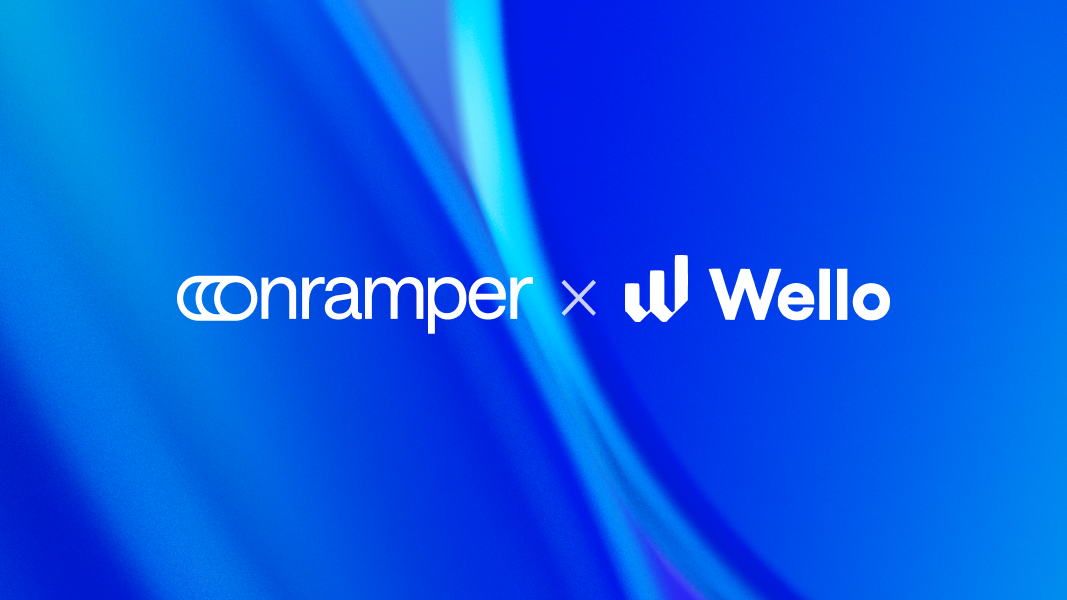
Wello Joins Onramper’s Network to Expand Crypto Onboarding in Nigeria
Collaboration strengthens Onramper’s Nigerian payment rails for all partners
December 19, 2025 – Onramper, the world’s leading fiat-to-crypto onramp aggregator, announced that it has integrated Wello, a global fiat on- and off-ramp provider, to increase crypto accessibility in Nigeria. By integrating with Onramper, Wello’s localized payment rails will reach a wider audience, beginning with Nigeria and expanding across Asia. This partnership is part of the broader plan to bring stablecoin-powered payments to local markets around the world.
Nigeria remains one of the most active crypto markets globally, but ensuring reliable and high-performing fiat-to-crypto rails in the country remains a challenge. By incorporating Wello’s localized infrastructure, Onramper strengthens its presence in the region and delivers smoother, more successful conversion paths for every partner operating in Nigeria.
“Wello will strengthen the global coverage of our aggregation engine,” said Thijs Maas, CEO of Onramper. “Its dependable and deeply localized infrastructure gives our partners, and their users, the onboarding experience they expect, in Africa and beyond.”
Wello brings strong regional expertise across Africa and the Middle East, with payment rails designed for fast-growing, high-adoption crypto markets. Its localized approach reduces failed transactions and improves uptime for Nigerian users.
Onramper continues to lead the onramp aggregation space, connecting more than 30 global fiat gateways and supporting over 2,000 digital assets. All partners integrated with Onramper will automatically gain access to Wello’s rails, unlocking improved payment methods, stronger reliability, and broader coverage in Nigeria without requiring any technical changes.
“Our goal is to build dependable stablecoin payment rails for users around the world,” said Helen Hai, Co-Founder at Wello. “Partnering with Onramper makes our infrastructure available to more wallets, exchanges, and platforms, unlocking a smoother, more efficient onboarding experience.”
Onramper’s global network supports more than 130 payment methods across 190+ countries. Its smart routing engine recommends the best available conversion in real time, maximizing the likelihood of a successful transaction and helping users receive the most crypto for their fiat.
To learn more, please visit onramper.com and wello.tech.
About Onramper
Onramper is the leading fiat-to-crypto payments aggregator, providing a turnkey API-based solution for dynamically routing fiat-to-crypto onramp flows based on algorithms optimizing for conversion, fees and payment methods. Onramper’s platform allows users of clients to buy 2000+ digital assets, in over 190 countries with over 170 payment methods in 120 currencies, with advanced routing options and unified analytics. The company is based in the Netherlands. To learn more about Onramper, visit www.onramper.com.
About Wello
Wello brings real utility to stablecoins. With compliant fiat on/off ramps, instant QR payments, and cross-border settlement. Wello’s mission is to bridge Web3 with real-world payments, empowering people to send global, spend local, effortlessly.
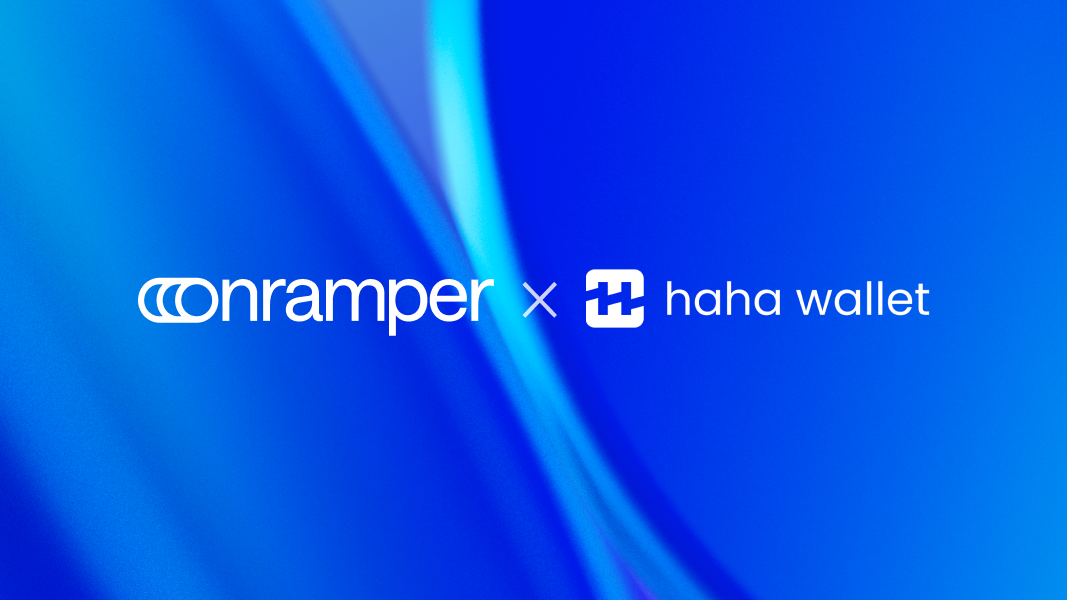
HaHa Wallet Partners with Onramper to Expand Access to the Monad Ecosystem
Partnership follows Monad Mainnet launch to unlock global onboarding
AMSTERDAM, Dec. 17, 2025 — Onramper, the world’s leading fiat-to-crypto onramp aggregator, today announced a strategic partnership with HaHa Wallet, next-generation, Monad-native crypto wallet, to broaden global accessibility for users engaging with Monad ecosystem.
Through the integration, HaHa Wallet users can now buy crypto using over 130 local payment methods across 190+ countries, benefiting from competitive rates and optimized fees. Following the launch of Monad’s public Mainnet in November 2025, the partnership makes it easier for users worldwide to enter Monad and begin trading, bridging, and exploring dApps.
HaHa Wallet has quickly become a leading gateway into Monad, offering a fast, intuitive, and reward-driven user experience. With Onramper’s global payments coverage and smart routing engine, users can move from fiat to crypto in just a few clicks and start interacting onchain.
“Realizing Monad’s full potential depends on frictionless onboarding,” said Thijs Maas, CEO of Onramper. “Our partnership with HaHa Wallet brings trusted, localized payment access directly into the Monad ecosystem. Together, we’re making it easier than ever for people everywhere to get started on Monad.”
Monad’s unique architecture enables parallel transaction execution, delivering faster speeds, quicker finality, and lower fees without sacrificing decentralization. Combined with Onramper’s global payment infrastructure, HaHa Wallet provides users with a streamlined entry point into Monad’s high-performance blockchain environment.
“Our focus is building the simplest possible entry point into the Monad Ecosystem,” said Mu Li, founder of HaHa Wallet. “Integrating Onramper allows us to offer trusted local payment methods, helping users get onchain quickly and confidently, no matter where they are in the world.”
Onramper continues to lead the onramp aggregation space, connecting more than 30 global fiat gateways and supporting over 2,000 digital assets, driving greater accessibility and inclusivity across Web3.
To learn more, please visit onramper.com and haha.me
About Onramper
Onramper is the leading fiat-to-crypto payments aggregator, providing a turnkey API-based solution for dynamically routing fiat-to-crypto onramp flows based on algorithms optimizing for conversion, fees and payment methods. Onramper’s platform allows users of clients to buy 2000+ digital assets, in over 190 countries with over 130 payment methods in 120 currencies, with advanced routing options and unified analytics. The company is based in the Netherlands. To learn more about Onramper, visit www.onramper.com.
About HaHa Wallet
HaHa Wallet is the Monad native, high performance smart wallet built to maximise how users earn and participate on chain. Purpose built for Monad’s low latency, parallel execution environment, HaHa delivers lightning fast swaps, deep native integrations with Monad dApps and ecosystem campaigns, and seamless access to multiple EVM chains through a single non custodial experience. Users earn Karma for meaningful on chain activity, unlocking rewards, ecosystem access, and future HaHa token utility, positioning HaHa Wallet as the primary consumer gateway to Monad and a rewards driven hub for Web3 participation.
For media enquiries, contact:

Introducing our new crypto trading portal: the easiest way to buy, sell and swap
Buying crypto should be simple. Selling and swapping should feel just as easy. That’s why we’re leveling up the Onramper experience to make this a reality.
Meet our new crypto portal, the world’s simplest all-in-one trading platform. It brings buying, selling and swapping together in one place with the best available fees and full global coverage.
One place for everything
It’s easy for trading flows to feel scattered, with buying, swapping and selling all living in different places. We set out to fix that..
Our portal brings everything together so the entire journey stays clear and straightforward from start to finish. You can now:
- Buy crypto with 170+ payment methods
- Sell back to fiat
- Swap 100K+ assets across 50+ networks, with 11+ liquidity providers
All from one clean, intuitive interface.
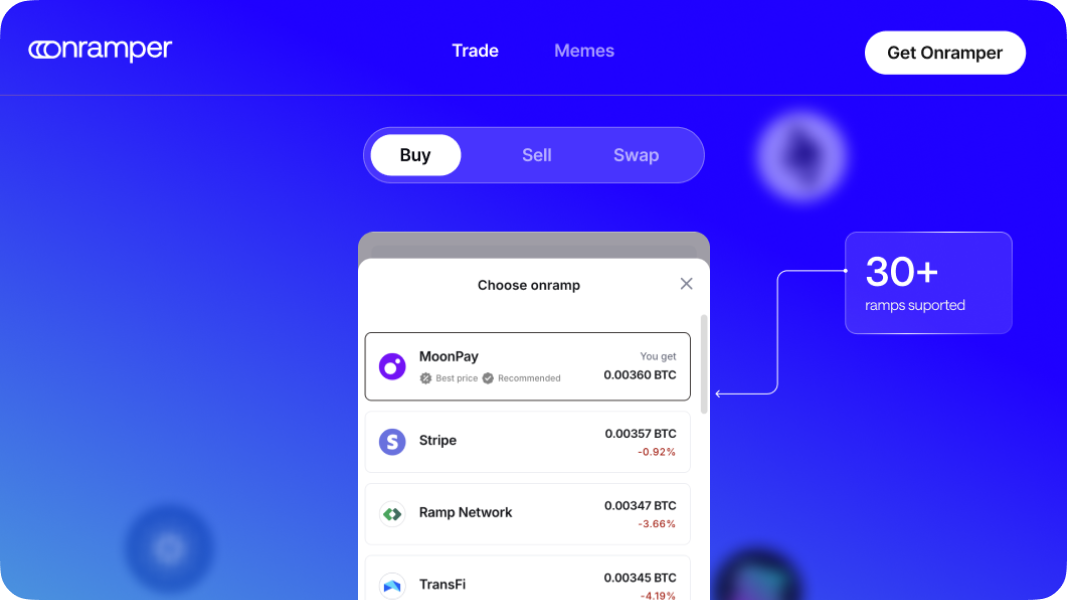
Always the best fees, automatically
Crypto pricing moves fast, with fees constantly shifting based on payment method, geography, KYC requirements and liquidity. Our smart routing engine tracks all of it in real time and selects the best provider automatically.
We do the work, and you get the best fees with the highest chance of transaction success.
Any payment method. Any user.
A global product requires global payment coverage. The new portal supports 175+ payment methods including cards, Apple Pay, Google Pay, bank transfers, regional options and alternative methods found in high-growth markets.
Since payment preferences vary by region, the interface automatically highlights the options that perform best in your area. This keeps the experience fast, familiar and easy for any user, anywhere.

Buy any memecoin on Solana with MoonGate
The rise of memecoins has changed what’s expected from a trading experience. People want speed, simplicity and access to the long tail of new tokens.
By integrating MoonGate directly into the portal, we deliver exactly that. You can:
- Sign in with Google or Apple to generate a wallet instantly
- Discover trending Solana tokens
- Buy or swap into any memecoin in seconds
No separate setup and no manual wallet creation. Just instant access.
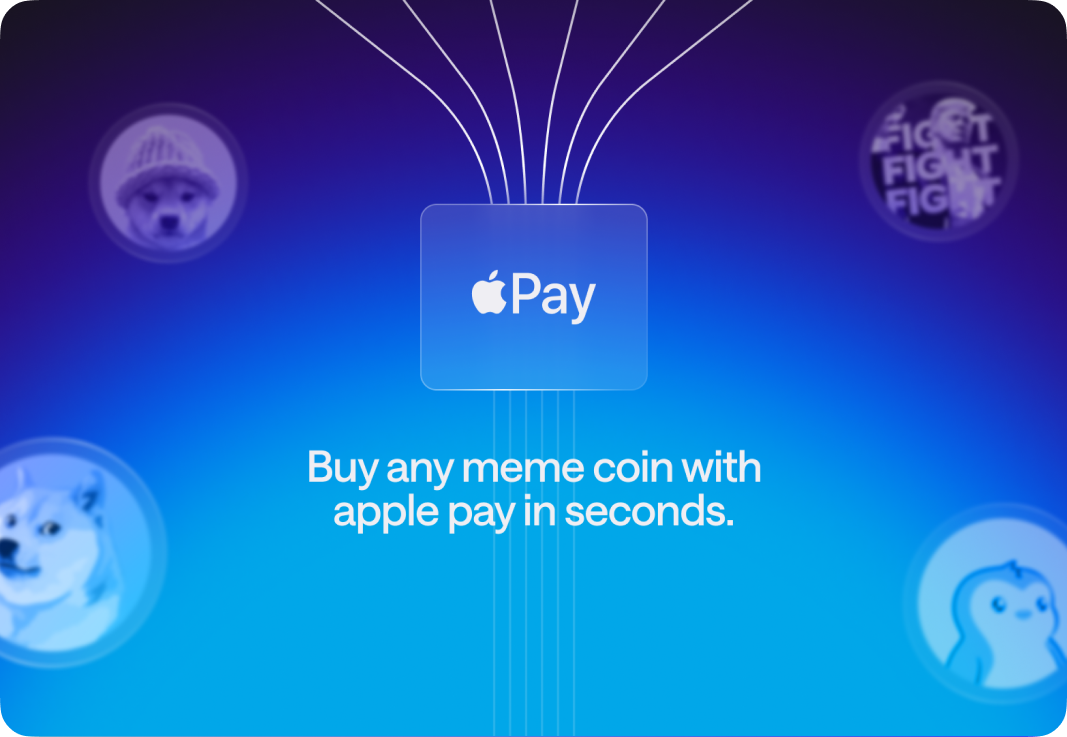
This is just the beginning
This portal isn’t an add-on. It’s a dedicated page built around a single widget that supports every trade type in one unified experience. And it’s only the first version.
We’ll continue adding new features that streamline the entire trading journey. From smarter token discovery to personalized payment suggestions, our goal is to create the smoothest crypto trading experience possible.
Try the full experience here: https://onramper.webflow.io/buy



















